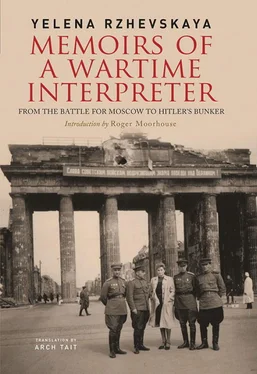‘The game’s up for the scum!’ (as if he were talking about a partner in crime who had ratted on him. Hitler was, after all, the only person the mistrustful Stalin had ever trusted, only to be perfidiously fooled by him). ‘Pity we couldn’t have taken him alive. Where’s Hitler’s body?’
‘As reported by General Krebs, Hitler’s body was cremated on a bonfire.’
‘Tell Sokolovsky,’ the Supreme Commander said, ‘to conduct no negotiations except on unconditional surrender, neither with Krebs nor with other Hitlerites. If nothing out of the ordinary happens, do not call until morning. I want to rest a bit before the [May Day] parade.’ Stalin thus terminated his conversation with Zhukov on the most sensitive topic of the time.
Stalin was not given to trusting people, but gave no orders then or subsequently to confirm the veracity of the message about Hitler. ‘Cremated on a bonfire.’ One way or another, he had disappeared. This left room for speculation that Hitler was still alive and in hiding. Hitler was no longer an emblem of the war: he became an emblem of the kind of peace that was to follow.
Zhukov, with his forthrightness, which Stalin had probably valued in the war, was quite unsuitable for joining in the imminent political games and, if he personally verified Hitler’s death, could even be dangerous. So he was abruptly sidelined and, we can imagine, must have been aware of it. Stalin never once asked him whether the search for Hitler’s remains was continuing.
Our newspapers, from 2 May onwards, alarmed their readers with TASS reports that Hitler had managed to escape. Pravda declared on 2 May:
Yesterday evening, German radio was broadcasting an announcement by the so-called ‘Führer’s General Headquarters’ to the effect that Hitler died on the afternoon of 1 May [sic]. The announcement continues that on 30 April Hitler appointed Admiral Dönitz as his successor… These German radio announcements are evidently a new Nazi trick. By spreading the claim that Hitler is dead, the German Fascists are clearly hoping to enable him to leave the stage and go underground.
So Hitler was alive and hiding somewhere? The question of whether he was alive or had committed suicide, and even more, the question of whether he had been found, moved from being an army matter into the sphere of international politics, so Zhukov may have deliberately moved aside on the grounds that this was not his province. A new day had dawned, with complex new problems and concerns, and the toppled dictator was demoted to yesterday’s news.
In my talk with Marshal Zhukov I mentioned that at that time we had the feeling that the front command was taking little interest in the search. Zhukov did not deny it. For some reason he had not insisted on receiving reports with all the details. He had ignored the issue. Why? Was it solely because of Stalin’s disinterest? I can come up with no convincing answer.
As for Stalin, he was not interested in seeing a search conducted, Hitler’s dead body discovered and the matter closed. That much is clear from how events were to develop.
The negotiations, which were now being conducted by Colonel General Sokolovsky, ended. The request for a truce was categorically rejected. Krebs was told that, as agreed with the three other Allies, only unconditional surrender could be discussed. Krebs was not authorized to accept that, and the talks ended with his return to the Reich Chancellery with that uncomfortable news. Colonel von Dufving was sent to Goebbels with a demand that he should surrender in order to avoid senseless bloodshed on both sides. Our command decided at the same time to set up a direct telephone line to Goebbels.
The signaller ordered to follow in Colonel von Dufving’s footsteps reached his destination safely, unwinding cable all the way and, with the assistance of German signallers, connected himself to their wire, plugged in his telephone equipment and let our side know that he was at the bottom of a crater, sheltering from any gunfire that might come from our side, in the amicable company of Fritzes, and having a smoke.
For the first time a direct telephone line connected the command posts of the opposing sides, but this entirely operational line was never used. The German side, which was expected to respond to the Soviet conditions, did not negotiate. While waiting for their decision, combat operations on our side were halted. Only at 18.00 hrs did an SS lieutenant colonel sent by Goebbels deliver, across the front line, the Germans’ written refusal to accept our conditions.
For Goebbels and Bormann personally, surrender had little to commend it. For them, capitulating to the Soviet side was tantamount to something worse than death. Saving the lives of German soldiers and of the German population was evidently not a priority. At 18.30 the Red Army, on the orders of Marshal Zhukov, resumed the assault. The unused hotline connecting the opposing sides was destroyed.
I often wondered what had happened to our signaller on the other side of the front line, lying in that crater with his German colleagues, alone in the enemy camp as the Red Army resumed its furious assault. Did the Nazi soldiers take their desperation and anger out on him in their darkest hour?
It was only in 1985, after being forgotten for so many years, that the heroic signaller resurfaced. I was so delighted to learn from a newspaper report that a Kazakh film about him had won an award at an international festival of documentary short films. All these years he had been living in Alma-Ata in obscurity.
Late in the evening of 1 May, the Hamburg radio station broadcast an announcement ‘from the Führer’s Headquarters’ that, ‘This afternoon, continuing the fight against Bolshevism to his last breath, our Führer, Adolf Hitler, fell in the battle for Germany at his command post in the Reich Chancellery.’ The announcement was broadcast a second time, accompanied by Wagnerian music. The circumstances had changed, but our task remained the same: to find Hitler, dead or alive.
The Führerbunker
Hitler’s headquarters was located in a bomb shelter under the Reich Chancellery. It had more than fifty rooms (most of them no bigger than a boxroom). It also housed a powerful communications centre, had food supplies and a kitchen. An underground garage was connected to it. There were two ways into the underground complex: from the internal garden of the Reich Chancellery, and from the Chancellery’s vestibule, from which a fairly broad and gentle staircase led downwards. Descending the stairs, you immediately came to a long corridor with numerous doors opening off it. The route to Hitler’s bunker was rather long and complicated. An entrance from the enclosed garden led directly to the Führerbunker, as those inhabiting this underworld called it.
The two-storey Führerbunker was much deeper down than the bomb shelter under the Reich Chancellery and its reinforced concrete ceiling much thicker. The head of Hitler’s bodyguard, Hans Rattenhuber, in his memoirs, Hitler, I Knew Him , [1] There are two typescript texts translated into Russian in the archive: Testimony of Hans Rattenhuber (file 132, pp. 63–91, titled ‘The Truth about the Death of Hitler’; also more detailed memoirs titled ‘Hitler As I Knew Him’ (file 131).
describes it: ‘Hitler’s new bomb shelter was the most solid of any built in Germany. The reinforced concrete ceiling of the bunker was eight metres thick.’
There was a concrete mixer near the garden entrance to the bunker: work had recently been carried out to strengthen the concrete roof, probably after it suffered a direct hit from artillery shells.
Russian assault detachments broke through the final defensive ring and burst into the Reich Chancellery on the morning of 2 May.
Читать дальше











